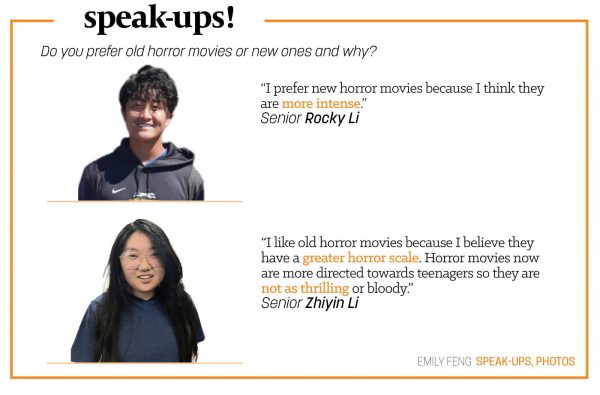Beginning in 1896 with George Mellies’ “Le Manoir du Diable,” horror movies have established themselves as films with the potential to become huge hits. Movies like the 1974 hit “Texas Chainsaw Massacre” and “Halloween” in 1978 have attracted generations of fans who live for the thrill. However, many fans, including myself, feel like modern horror films do not measure up to their predecessors. The 2010 remake of “A Nightmare of Elm Street” disappointed fans across the world through the bland acting, subpar special effects and overall inability to create the same suspense and fear in the audience that the originals did. The root of this problem isn’t simply that remakes are bad, but rather that something is fundamentally wrong with the producers of the modern horror genre.
Classic horror movie artists had to work with the technology of their day to make realistic horror films, and that makeup and set design tends to look so much cleaner and scarier than modern CGI monsters and sets. In “The Sixth Sense,” director M. Night Shyamalan, rather than using CGI, placed actor Haley Osment into a real ice box to capture videos of his breath, feeling that CGI would look strange in his film. CGI takes so much of the thrill out of horror. Even when the CGI is hyperrealistic, it is still obviously CGI, partly because of the attention to detail. Watching CGI monsters, ghosts, and witches somehow makes the horror films feel less scary. Modern CGI, like in the 2017 film “Truth or Dare,” can come out looking weird. The CGI in “Truth or Dare,” which gives the characters creepy smiles, comes off looking like a disfigured snapchat filter. This look could’ve been done with makeup, which would make it more realistic and less like a filter, instantly upgrading the fear factor.

Modern horror movies also have a problem with jumpscares. It feels like the modern horror movie uses a jumpscare like a crutch. Whenever the plot feels lacking or the suspense is down, directors throw in a jumpscare. While jumpscares can be frightening, when there are so many of them in these films, they stop being unexpected. These horror movies create suspense by trying to get the viewer to be constantly worried about when the next jumpscare will be, but the best of the old horror movies create suspense naturally through good plot and eerie scenes. Jumpscares feel like a cheat code. They instantly activate a person’s fight or flight response, which is scary, but horror films shouldn’t need to count on that natural reaction to a sudden scary face on screen to elicit fear out of their audience.
Overall, horror filmmakers need to take a look back at what made old horror film movies so incredible in the first place. Handmade special effects, plots with good substance and the buildup of fear throughout the movie are the cornerstones of a good horror movie. Returning to these basics and then building up will help the horror genre return to greatness. Supporting indie filmmakers who don’t have access to expensive CGI and A list actors is the best way for viewers to help horror movies be amazing again. This will show big directors and producers what people truly want, and only then can viewers finally watch good horror movies again.
The views in this column do not necessarily reflect the views of the HiLite staff. Reach Katie Maurer at kmaurer@hilite.org.































![What happened to theater etiquette? [opinion]](https://hilite.org/wp-content/uploads/2025/04/Entertainment-Perspective-Cover-1200x471.jpg)













































![Review: “The Immortal Soul Salvage Yard:” A criminally underrated poetry collection [MUSE]](https://hilite.org/wp-content/uploads/2025/03/71cju6TvqmL._AC_UF10001000_QL80_.jpg)
![Review: "Dog Man" is Unapologetically Chaotic [MUSE]](https://hilite.org/wp-content/uploads/2025/03/dogman-1200x700.jpg)
![Review: "Ne Zha 2": The WeChat family reunion I didn’t know I needed [MUSE]](https://hilite.org/wp-content/uploads/2025/03/unnamed-4.png)
![Review in Print: Maripaz Villar brings a delightfully unique style to the world of WEBTOON [MUSE]](https://hilite.org/wp-content/uploads/2023/12/maripazcover-1200x960.jpg)
![Review: “The Sword of Kaigen” is a masterpiece [MUSE]](https://hilite.org/wp-content/uploads/2023/11/Screenshot-2023-11-26-201051.png)
![Review: Gateron Oil Kings, great linear switches, okay price [MUSE]](https://hilite.org/wp-content/uploads/2023/11/Screenshot-2023-11-26-200553.png)
![Review: “A Haunting in Venice” is a significant improvement from other Agatha Christie adaptations [MUSE]](https://hilite.org/wp-content/uploads/2023/11/e7ee2938a6d422669771bce6d8088521.jpg)
![Review: A Thanksgiving story from elementary school, still just as interesting [MUSE]](https://hilite.org/wp-content/uploads/2023/11/Screenshot-2023-11-26-195514-987x1200.png)
![Review: "When I Fly Towards You", cute, uplifting youth drama [MUSE]](https://hilite.org/wp-content/uploads/2023/09/When-I-Fly-Towards-You-Chinese-drama.png)
![Postcards from Muse: Hawaii Travel Diary [MUSE]](https://hilite.org/wp-content/uploads/2023/09/My-project-1-1200x1200.jpg)
![Review: "Ladybug & Cat Noir: The Movie," departure from original show [MUSE]](https://hilite.org/wp-content/uploads/2023/09/Ladybug__Cat_Noir_-_The_Movie_poster.jpg)
![Review in Print: "Hidden Love" is the cute, uplifting drama everyone needs [MUSE]](https://hilite.org/wp-content/uploads/2023/09/hiddenlovecover-e1693597208225-1030x1200.png)
![Review in Print: "Heartstopper" is the heartwarming queer romance we all need [MUSE]](https://hilite.org/wp-content/uploads/2023/08/museheartstoppercover-1200x654.png)



![Chilling or Childish? The downfall of modern horror movies [opinion]](https://hilite.org/wp-content/uploads/2024/10/adjusted-horror-cover-1200x471.jpg)